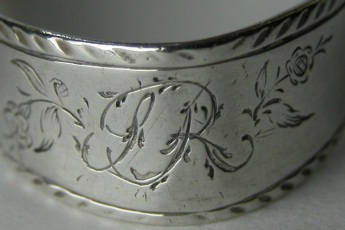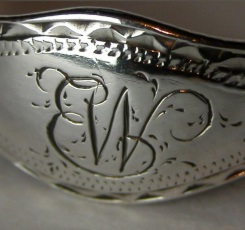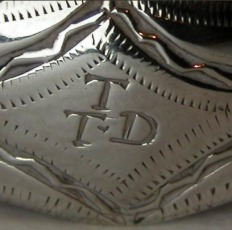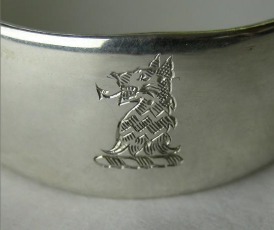|
(click on images to enlarge)
GEORGIAN SILVER SUGAR TONGS
of the period 1770 to 1820
This period of English history was a time of great change and a time
of great prosperity for England. As a result of this prosperity it was a
growth period for silver table-ware, much of which still survives today.
For sugar tongs, this period saw the change from tea tongs, through cast
sugar tongs to the standard style sugar tongs, (or sugar bows). It is
also the period when bright cut engraving was at its peak.
Cast tongs are relatively rare and rarer still are cast tongs that are
un-damaged for, despite appearance, they are very delicate.
These were made in 3 pieces, the two arms and the bow. The bow was
soldered to the two arms and usually the hallmark and maker’s marks were
stamped at the joins.
|
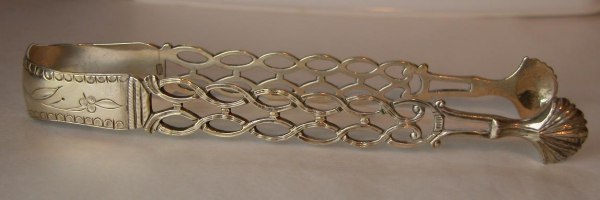
|
|
A pair of cast tongs by Elizabeth Taylor c 1775
|
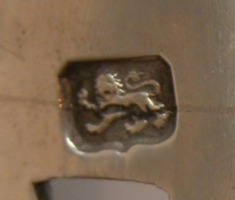 |
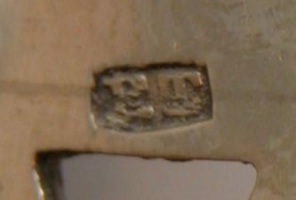 |
Lion passant mark
|
Elizabet Taylor mark
|
Cast tongs only lasted a very short time, from about 1765 to 1780.
After this came the standard sugar tongs. To start with they were plain
or with a simple thread or beaded edge but very soon the fashion for
bright cut engraving took over and dominated sugar tongs through to the
early 1800’s.
|

|
|
An early pair of beaded sugar tongs by George Burrows I c1780
|
Whilst the vast majority of these sugar tongs were assayed in London,
they were also made in the provinces, most notably Newcastle. From
Newcastle we see sugar tongs made by all the well known makers of the
time including the Robertsons, the Langlands and Thomas Watson.
We also see examples of tongs assayed in Exeter, York, Sheffield,
Birmingham, Edinburgh and Dublin. In fact the Irish tongs are some of
the very best examples of sugar tongs of this period.
The real focus must however be London, where a huge number of sugar
tongs were produced by many different makers. This period saw the
creation of some of the big silver-ware companies, for example the
Chawner company.
There are many sugar tongs hall-marked by silver-smiths who were part of
the great Chawner company, including William & Thomas Chawner, Richard
Crossley and the Williams, Eley & Fearn, to name but a few.
However, no study of sugar tongs of this period can be undertaken
without considering the Bateman family. Silver sugar tongs of the
Georgian period are dominated by the Batemans. Of all the makers, they
were the most prolific by far. These tongs are also the most well known
and are recognized by all collectors, not just of sugar tongs, but of
most types of silver of this period. From my collection of London sugar
tongs, over 25% are from the Bateman workshops, and they did not
specialize in flatware only!
The style of Bateman sugar tongs is very distinctive, and I would
maintain, different from all others, starting with Hester and right
through to William Bateman I.
|

|
|
A pair of Hester Bateman Adam style sugar tongs, dated c1780
|
|

|
|
A pair of Peter & Anne Bateman, flared and shaped bright cut
tongs dated 1798
|
The Batemans were not alone though. There were many other makers.
From my collection I have identified over 130 different London maker’s
marks for silver sugar tongs during this period, and this will be by no
means all of them. The size, shape and style of these tongs varies
considerably, not just between different makers, but also between tongs
made by the same maker.
|

|
|
An early pair of flared, Adam style tongs by Benjamin
Mountigue, dated c1780
|
|
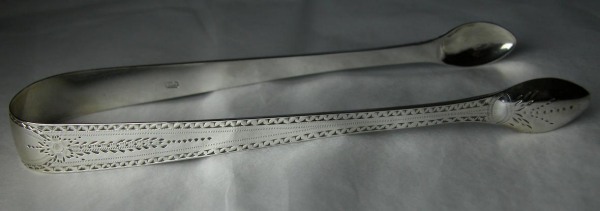
|
|
A pair of “standard” style tongs by Charles Hougham, dated
c1790
|
The style and shape of the Charles Hougham tongs shown above is much
more 'the norm'. There are many, many examples of tongs very similar to
these.
Of course the most fascinating aspect of this subject is the variety –
it is extremely unlikely that you will ever see two identical pairs of
bright cut tongs. Interestingly it is the Batemans who made more
'identical' tongs than any other maker, although, as they were all hand
made, even these are not quite identical.
Gradually, the fashion for bright cut engraving died away and by
1805-1810, we start to see more and more plain or 'Old English' style
tongs, until by about 1820, bright cut engraving had virtually died
away.
This timing coincided with the introduction of the standard patterns,
(King’s pattern and Fiddle pattern), and the increase in the use of
mechanization.
|

|
|
A pair of Peter & William Bateman plain tongs, dated 1812.
|
In a study of these sugar tongs, we should also look at the cups.
Again these come in many styles, shapes and sizes.
A range of cup styles
The final part to look at is the monogram. On many pairs of tongs, the
monogram has been removed, often badly. This will have been done in
order to sell the item or, having been sold, to put a new monogram to
it. Often the monogram will be dated later than the original tongs.
It also seems that sugar tongs have been a very popular betrothal or
wedding gift and are initialed as such. Many people prefer to see a
piece without the monogram. Personally I like to see monograms because
they add the personal touch to a beautiful piece of 200 year old British
history.
Graham Hodges - 2005 © -
ASCAS Member Graham Hodges has created
www.silversugartongs.com,
a highly informative web-site fully devoted to Georgian silver sugar
tongs
|















